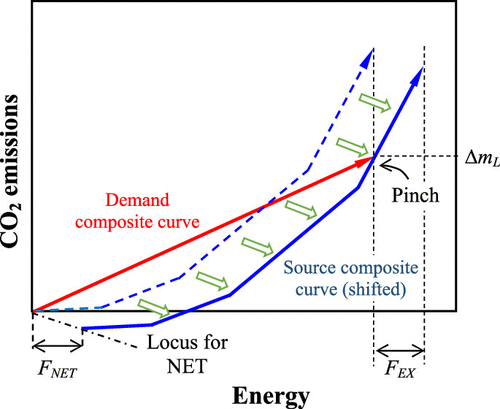当前位置:
X-MOL 学术
›
Ind. Eng. Chem. Res.
›
论文详情
Our official English website, www.x-mol.net, welcomes your
feedback! (Note: you will need to create a separate account there.)
Extended Graphical Approach for the Deployment of Negative Emission Technologies
Industrial & Engineering Chemistry Research ( IF 3.8 ) Pub Date : 2020-09-18 , DOI: 10.1021/acs.iecr.0c03817 Purusothmn Nair S. Bhasker Nair 1 , Raymond R. Tan 2 , Dominic C. Y. Foo 1
Industrial & Engineering Chemistry Research ( IF 3.8 ) Pub Date : 2020-09-18 , DOI: 10.1021/acs.iecr.0c03817 Purusothmn Nair S. Bhasker Nair 1 , Raymond R. Tan 2 , Dominic C. Y. Foo 1
Affiliation

|
It is critical to limit global warming to 1.5 °C by the year 2100 to minimize catastrophic impacts. The increased integration of renewable energy, alongside CO2 capture and storage (CCS) deployment in energy planning, remains as a key mitigation technique in minimizing climate change impacts. Although renewable energy generation approaches the ideal of a carbon-neutral system, other processes such as fossil fuel-based generation, manufacturing, and transportation are net-carbon positive. Additionally, renewable energy poses challenges such as its sensitivity to environmental conditions, geographical location, and seasonal changes. On the other hand, CCS entails a high capital expenditure, as well as additional operating costs due to parasitic power loss. Therefore, the deployment of negative emission technologies (NETs) as a carbon management option is imperative. The generation of electricity from power plants with the installation of NETs can offset positive emissions from elsewhere in a system. This paper presents an extended graphical technique for the incorporation of NETs during energy planning. The graphical technique that was originally developed for the planning of CCS deployment in power plants is now extended to determine the minimum NET requirement during energy planning. Three examples are solved to illustrate the methodology of the extended graphical technique in determining the minimum NET requirement during energy planning.
中文翻译:

部署负排放技术的扩展图形方法
至关重要的是,到2100年将全球变暖限制在1.5°C以最大程度地减少灾难性影响。可再生能源与能源计划中的CO 2捕集与封存(CCS)部署不断加强的集成,仍然是最大程度地减少气候变化影响的关键缓解技术。尽管可再生能源的发电接近碳中和系统的理想状态,但其他过程(例如基于化石燃料的发电,制造和运输)对净碳有利。此外,可再生能源还面临挑战,例如其对环境条件,地理位置和季节变化的敏感性。另一方面,由于寄生功率损耗,CCS会导致高昂的资本支出以及额外的运营成本。因此,部署负排放技术(NETs)作为碳管理的选择势在必行。安装了NET的发电厂产生的电力可以抵消系统中其他位置的正排放。本文提出了一种扩展的图形技术,用于在能源规划过程中纳入NET。最初为规划电厂CCS部署而开发的图形技术现已扩展为确定能源规划期间的最低NET要求。解决了三个示例,以说明扩展图形技术在确定能源计划期间的最低NET要求方面的方法。
更新日期:2020-10-21
中文翻译:

部署负排放技术的扩展图形方法
至关重要的是,到2100年将全球变暖限制在1.5°C以最大程度地减少灾难性影响。可再生能源与能源计划中的CO 2捕集与封存(CCS)部署不断加强的集成,仍然是最大程度地减少气候变化影响的关键缓解技术。尽管可再生能源的发电接近碳中和系统的理想状态,但其他过程(例如基于化石燃料的发电,制造和运输)对净碳有利。此外,可再生能源还面临挑战,例如其对环境条件,地理位置和季节变化的敏感性。另一方面,由于寄生功率损耗,CCS会导致高昂的资本支出以及额外的运营成本。因此,部署负排放技术(NETs)作为碳管理的选择势在必行。安装了NET的发电厂产生的电力可以抵消系统中其他位置的正排放。本文提出了一种扩展的图形技术,用于在能源规划过程中纳入NET。最初为规划电厂CCS部署而开发的图形技术现已扩展为确定能源规划期间的最低NET要求。解决了三个示例,以说明扩展图形技术在确定能源计划期间的最低NET要求方面的方法。











































 京公网安备 11010802027423号
京公网安备 11010802027423号